Five unforgettable days in Los Angeles
I witnessed: A video game inspired by Monica Lewinsky, Princess Peach protesting against ICE at City Hall, the silver lining to the 1990s Mortal Kombat scandal, and a whole lot of Summer Game Fest
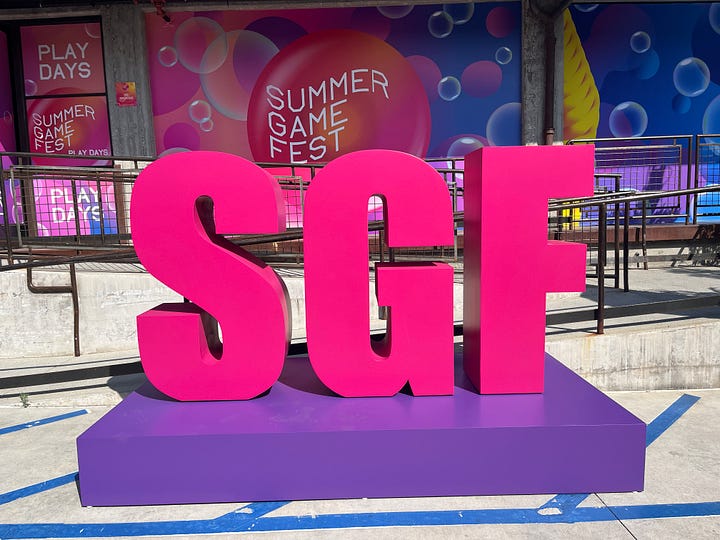

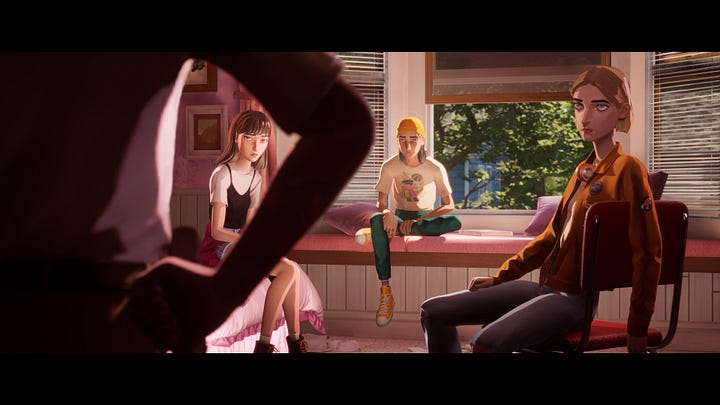

As I embarked to Los Angeles last week, it crossed my mind that this year’s Summer Game Fest would probably be less eventful for me than 2024’s, because, this time, my cat hadn’t peed in my suitcase.
It is a considerable inconvenience to start a multi-day series of formal and informal meetings with video game developers and then realize that one’s entire packed wardrobe has the odor of feline urine.
I’d solved that situation last June with a desperate visit to a stripmall laundromat and the urgent purchase of a new suitcase. I conducted dozens of interviews after that and no one scrunched their nose.
This year, there was no cat piss. Just the President of the United States commandeering the National Guard to confront protestors seven blocks from my hotel.
But, first there were video games.
Thursday, June 5
Right off the plane, I took a Lyft to Activision’s offices in Santa Monica. In a mini-theater, alongside reporters from one other outlet—and with at least two dozen officials from Microsoft and Asus looking on—I was shown the upcoming ROG Xbox Ally X, aka the first Xbox-branded gaming handheld. The Xbox Ally has such an open approach to playing Windows games that it’ll likely be the first device on Earth that a) has an Xbox button and b) can play God of War.
Fun discovery: There’s a train station right outside Activision’s offices that can bring you to downtown LA for $1.75.
Friday, June 6
I filed a newsletter about Switch 2 games and brainy Steam Deck demos, then watched a chunk of Geoff Keighley’s two-hour Summer Game Fest trailer showcase while running on the hotel treadmill. The highlight for me wasn’t the unveiling of the ninth big Resident Evil but the reveal of Rise of the Deceiver, a new Wu-Tang Clan video game that my buddy and former Kotaku colleague Evan Narcisse is working on.
Another Kotaku alumni benefit: Former JRPG columnist Jason Schreier drove me to an event in Hollywood for Io Interactive, where I chatted with a studio executive about young James Bond. We then zipped back to downtown LA for The Mix, a semi-annual indie showcase, on the rooftop of the Grammy Museum (One of the museum’s featured events: The Music of Cobra Kai.)
Up on that rooftop, Zhenghua “Z” Yang spotted me. He runs indie studio Serenity Forge and walked me over to set-ups running two video games that he’s directing. On the left was Fractured Blooms, a creepy first-person “psychological life sim,” and on the right was a visual novel called Return to Ash.
Nodding toward the one on the right, Z said it’s a game about being socially ostracized, about being known just for something that happened early in life and being shunned. “It's inspired by people like Monica Lewinsky, someone who made a mistake at a young age,” he said. She shouldn’t have been maligned for her affair with former president Clinton, certainly not for so long, he said. The game is “our way of creating a piece of art to comment on that problem in our society and how, maybe there's better ways to handle it.”
As for the game on the left, Fractured Blooms, “the inspiration of the game is a pretty big spoiler,” he said. “It's inspired by American culture. We wanted to make a game that everyone could enjoy.” I was baffled by that. The trailer had shown a person chopping tomatoes and walking through an empty house, as the narration turned from talking about “plates of food” to “plates of pain” to “plates of her legs.” He also said the game was influenced by the TV show Lost. Sold.
At any LA gaming event, the press and game industry people magnetize to the bar at the JW Marriott. I was drawn there Friday night. So were some guys who wanted to demo me a game. And so was game-loving pro-wrestler Adam Cole. I thanked him for his in-ring labor and recommended that he play Blue Prince. He told me he wants to get back to it, but is currently enjoying Clair Obscur. Fair enough.
The industry vibe at the hotel: publishers and investors want more from developers for less money. Some said that outright; others just groused about the companies backing their studios.
Saturday, June 7
One big difference between E3 and Summer Game Fest is that the former filled the airplane-hangar-sized Los Angeles Convention Center. The latter features a multi-day Play Days showcase of playable games, set up across several buildings that occupy a city block in LA’s fashion district. (See the map)
My first stop was to see a Pac-Man Metroidvania called Shadow Labyrinth. More about that one in a future newsletter.
Second up was Toem 2, a peaceful, black-and-white game that switches to first-person when you use your camera. Much of the gameplay involves snapping pictures. When I played the first Toem, I wanted a little more to do. My request has been answered. This time, the camera also has a hammer, for bashing blocks in first person.
I did not have an appointment to see Sword of the Sea, but how could I not stop to gawk at a sand-surfing game from Giant Squid? Their prior games, Abzu and The Pathless, look and play like interactive dreams.
Sword of the Sea creative director Matt Nava told me he was inspired by snowboarding and surfing, but felt that games tapping into those sports often try to make things feel extreme. This game will have more of a “spiritual,” relaxing vibe:
“When you're snowboarding, you're going fast, and it's really fun to go fast. But what that really lets you do is: it lets you see more places quicker, almost at the same time. It lets you understand the place more. It lets you see it more deeply. And so you get to connect with it more deeply.”
The game’s been in development for four years, is out in August and looks great.
Right near Sword of the Sea was a set-up for Blighted, a new game from Guacamelee studio Drinkbox. Whoever was supposed to meet with Drinkobox at the time had no-showed, so I did an impromptu interview. More Blighted coverage in a future Game File.
I next hopped over about 15 feet to play Remedy’s upcoming—as in next week—three-player co-op Control spin-off FBC: Firebreak. I ran through one session in a group with the ubiquitous HipHopGamer and influencer Parris Lilly. Their characters wielded machine guns; mine had a hose. We battled enemies attacking us in an office building, while we tried to complete the level’s goal: destroy lots of off-brand PostIt notes. I got careless, and the notes started sticking to my character and blocking my vision. Thankfully, the level had a shower that let me wash them off. Pretty weird. And fun!
In another building, I handed a ticket to a Capcom official so that I could attend a hands-off group demo of Onimusha: Way of the Sword and Resident Evil: Requiem. This was E3-esque. You watch as people from the game company play a portion of the game live. A company rep narrates what is happening, acting surprised or excited even though we all know they’ve done this patter several times already. Some people in the audience hoot and holler at the most grisly scenes. This always happens. For Onimusha, it was when hero Miyamoto Musashi parried an enemy archer’s arrow back at him, and then when he was slicing demonic enemies in half. More Onimusha coverage in a future Game File.
The next game I was supposed to play was Pragmata, a Capcom game announced in 2020, but there was a sudden commotion in the Capcom building. Hideo Kojima was walking through, with Geoff Keighley at his side. They posed for pictures with longtime Monster Hunter producer Ryozo Tsujimoto, who now oversees all consumer game development at Capcom. Once they left, I noticed Microsoft’s three most senior gaming executives, Phil Spencer (gaming chief), Sarah Bond (Xbox president) and Matt Booty (game studios lead) walking by outside.
But… Pragmata? It’s a third person shooter, and, for the first time in my career, I was scolded by a game company official for trying to invert the Y axis. “You have to play the game as it is,” they told me. “I’m going to have a bad time,” I warned them, baffled at them restricting my use of an option that was right there in the settings screen.
I was wrong. I may have repeatedly looked at the floor when I meant to look up, but I actually had a great time.
You’re this big guy named Hugh who has to shoot robots, but they’re armored. Thankfully, a little girl named Diana clings to your back and can hack the enemy’s shields. This plays out as a third-person shooter that requires that you rapidly play an increasingly complex hacking mini-game as the enemy approaches. That does not sound nearly as good as it felt. But trust me. A lot of attendees buzzed about this being one of the show’s best-playing games.
Outside of the Capcom building, across a bocce court, I found a building set up for Annapurna Interactive. I played two games: Mixtape, a slick game about suburban teens in the 1990s that plays like a sequence of interactive music videos, and Snap & Grab, an over-achieving demo about a photographer named Nifty Nevada, who takes pictures of a place where she wants to stage a heist (in this case, the swanky party mansion of an obnoxious artist named Erik Pop), then lays those photos out on a timeline to plan and trigger a heist.
Trend alert: It was one of three games about thievery that I played at Summer Game Fest. Wonder what that’s about.
The next game I played was Bandit Trap, billed to me by a savvy PR person as “Home Alone meets Overcooked.” It’s a 3v1 multiplayer game played from an overhead perspective. Three players are the bandits, who infiltrate a house to grab the valuables inside. The other player booby-traps the house with high-speed fans, boxing gloves and homing missiles. You can turn couches into giant slingshots.
Sunday, June 8
I filed a newsletter about the Xbox handheld, then watched some of the Xbox Gaming Showcase from the hotel treadmill (yep, two runs accomplished during Summer Game Fest). I then booked it to what was meant to be a day’s worth of Xbox-related game demos.
First, at 1pm PT, was Ninja Gaiden 4, which I was able to play for about 20 minutes. It’s tough, as the franchise always has been, but not back-breaking. More notably, the adventures of this ninja in a futuristic city play out lightning fast. Jumps, sword strikes, dodges… they are each an eye-blink.
After the demo, three other reporters and I sat across from developers from Ninja Gaiden studio Team Ninja and action game specialists PlatinumGames. The developers were from Japan, and a translator facilitated the Q&A.
The game was born from a friendship between the heads of Team Ninja and Platinum with the interest and “backing” of Microsoft gaming chief Phil Spencer, the developers told me. (We did not get into the oddity that this is a Microsoft-published, third-party-developed game that’ll come to PlayStation, as well as Xbox and PC). Initial conversations to make the game started five years ago, the developers told me.
“The game is very close to completion, Yuji Nakao told me. “We're just applying final touches, doing final balancing and polish. And since we've come to LA, we've been talking in the hotel… to iron out those final balancing details.”
The elephant in the room was the state of Platinum, which has had a slew of major departures lately. I asked how the studio is doing and what message Platinum has for its fans with this game.
“Through Ninja Gaiden 4, we want to show that hack and slash games are here for the current generation,” Nakao said, through the translator. “And among that genre, through Ninja Gaiden 4 we want to show you that PlatinumGames is a heavy player in that field.”
I politely followed up, repeating the first part of the question. How is the studio faring? A second Platinum official sitting nearby, who’d been taking notes, said in English, something to the effect of “we are fine,” while the translator came back with an answer from Nakao that the studio is “confident” in what they’re making. (Apologies for the imperfect read-back of what was said, but the room’s acoustics made my audio recording all but unusable, and the notes I took were incomplete, because I was stressing about my next thing…)
I was supposed to check out Gears of War Reloaded next, at 2pm PT, but I told Microsoft PR I’d be skipping it.
I’d read the night before that anti-ICE protests would be happening at Los Angeles City Hall at that time, and I wanted to witness them, given how the protests against President Trump’s immigration crackdown in LA the first two says I was in town had already become national news. The President of the United States was overriding the Governor of California to order the state’s National Guard to get involved. I’m a reporter. I couldn’t ignore this.
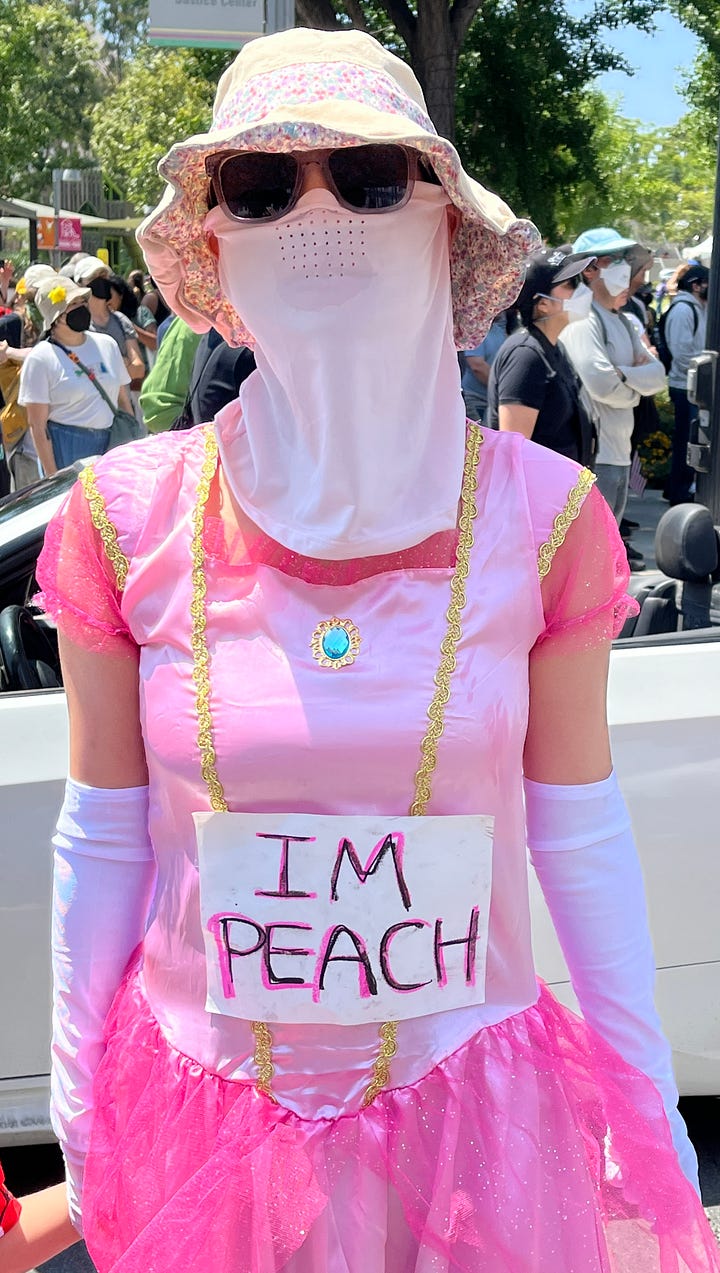
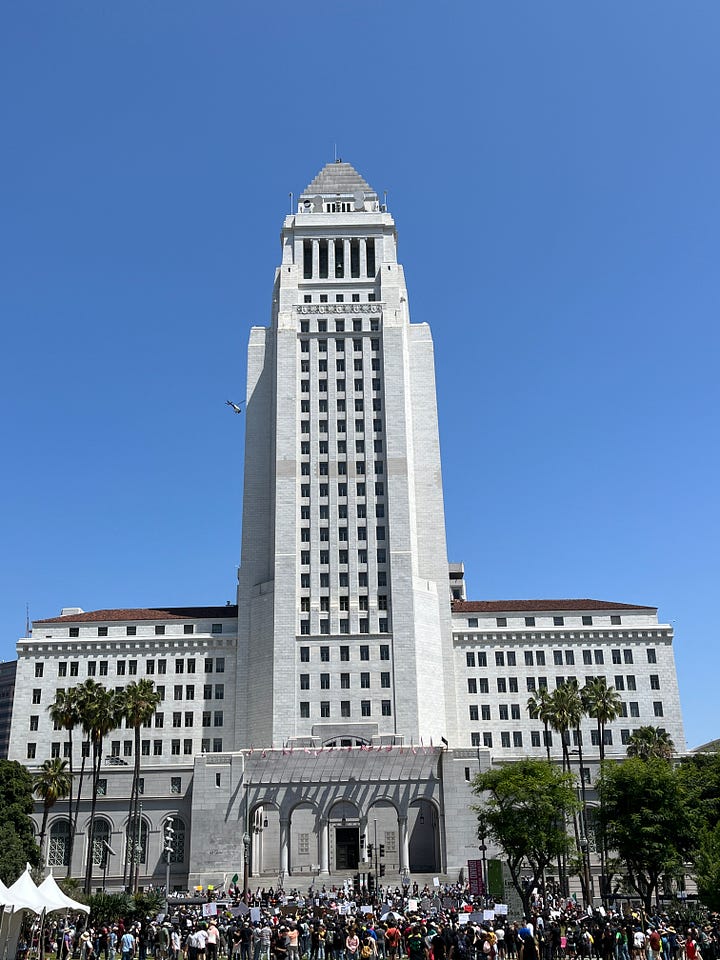
I hopped into a Lyft and, nine minutes later, was near City Hall. I walked into a gathering of a few hundred people, including some families, and just one woman dressed as Princess Peach (her sign, “IM PEACH,” was a pun.) Over a bullhorn, a woman led the crowd in a chant: “All power to the people; no human is illegal.” The protest was peaceful, lots of people were masked. LAPD HQ is right next to City Hall, but at the kick-off of the day’s protest, I didn’t notice any significant police presence. I snapped some photos, got a feel for the scene, and left, as more and more people were arriving. I hopped in a car back to the Xbox event, for my 3pm.
Grounded 2, Obsidian’s sequel about miniaturized people vs. nature, was up next. I’ll cover that one in a future Game File.
I briefly played Invincible Vs., a team fighting game developed by former Killer Instinct developers. It was mostly lost on me, as I’m not into the genre.
After that: Obsidian’s sci-fi role-playing game The Outer Worlds 2. I played through the demo as a combat specialist, using two AI-controlled buddies to shoot through a heavily guarded research facility in order to grab a gadget that interacts with energy rifts (and creates floating platforms when it does). Then I re-played it with a stealth build, but alerted too many guards and was back to combat.
We did a group interview. It was me, Ralph “SkillUp” Panebianco and Kinda Funny’s Greg Miller chatting with the game’s director, Brandon Adler, who effectively conveyed that the new game is bigger than the first.
Outer Worlds was released just months apart from Mobius Digital’s Outer Wilds, so I wondered if Obsidian had checked with Mobius to ensure that there isn’t an Outer Wilds 2 releasing any time soon. “No comment,” he said, laughing.
I was also curious about the jokey, anti-corporate tone that’d been key to the first Outer Worlds, and whether it gets awkward making that kind of game while being owned by Microsoft. “I like poking fun at it,” he said. He added: “A lot of this stuff is timeless, right? It's not even talking about something that's going on right now or our current situation or any of that. These are things that are just long-term things that you see over the course of humans existing.”
I returned to the JW Marriott hotel bar that evening and spoke to a game developer who’d gone to the protests a few hours after I’d been there. It was more unruly when he went. He saw two Waymo cars that protestors had lit on fire, saw police shooting tear gas at protestors on a pedestrian bridge, saw protestors throwing water bottles.
On the way back to my hotel, which was equidistant from the JW and City Hall, I started seeing anti-ICE graffiti and an assemblage of police guarding an Adidas store. I walked toward City Hall. I saw a looted Nike store, a stream of police cars tearing down the road, and one firework light up the sky. Helicopters with searchlights flew overhead. Near City Hall, the police had cordoned off a couple of blocks, with protestors supposedly inside. Make what you will about how anyone was protesting, but the whole affair was objectively happening in the tiniest of areas. That looted Nike store was several blocks away; a couple of young guys showed me a clip they recorded of the looting. There were no anti-ICE signs among them, no flags, just the appearance of an opportunistic mob.
Monday, June 9
I was wiped out by Monday morning but had another day’s worth of demos.
First, Relooted, a game about stealing back artifacts from museums that initially stole them. More about that game in a future Game File.
Then Dosa Divas from Outerloop, a studio consistently finding new ways to work cooking into games you wouldn’t expect. In this case, Dosa Divas is a colorful turn-based role-playing game: sisters Samara and Amani drive a customizable food truck mech that can gather ingredients, help them fight in Paper-Mario-inspired turn-based battles, and cook food for people in various villages.
The dystopic flavor of this game is that a third sister has started a dominant fast food company. “People have forgotten how to cook,” Outerloop creative director Chandana Ekanayake told me, saying the game is also a bit about the game industry. It’s a critique of people “just being okay with corporations running things and forgetting how to do things for themselves.”
It was one of the loveliest-looking games at the showcase.
Next, I interviewed Capcom’s lead Onimusha developers, then doubled back to see two games from Atari: Digital Eclipse’s latest interactive history piece, the Mortal Kombat Legacy Kollection and Ilex Games’ Adventure of Samsara.
The collection mostly includes scores of 2D Mortal Kombat games—arcade games, SNES “sweat” version of MK, the “red blood” Genesis version, even a Game Gear 32X Mortal Kombat, up to the 3D Mortal Kombat 4. Atari-owned studio Digital Eclipse has done a terrific job with numerous collections that double as interactive documentaries (Atari 50, The Making of Karateka, etc.), except I wish they had a little more edge. But I get it. Digital Eclipse needs to get permission from the involved studios to bundle their games into these projects might result in some sanded corners.
Digital Eclipse has gotten more editorial freedom with these projects over time, the studios Stephen Frost told me. “People see now what we're doing, they trust that we're trying to tell an accurate but, you know, a good story, like a balanced story, warts and all, and they see the treatment of it and the reception of it across these products. [They also see] the people who are willing to work with us and they're like, ‘Ah, I trust these guys.’”
The Kollection will at least touch on Mortal Kombat being a focus in the early 1990s in the debate over violent video games (which involved U.S. Senate hearings and the creation of the ESRB game ratings). Frost said that Mortal Kombat co-creator Ed Boon, who was interviewed for the Kollection, and other developers from that era, shared a positive take on the game violence drama. "They came up from a different perspective, which is: ‘You know, music and movies were already treated very seriously, and they had ratings attached to them. They had reached a mainstream size, where it was relevant. Getting ratings on games was almost kind of like this moment where, ‘Hey, people are treating games seriously, it's reached a scope that it needs ratings.’”
I’ll get back to Adventure of Samsara in a future edition of Game File, along with my final Monday games, which I can’t squeeze in here: Escape Acadamy 2, Petal Runner and Ambrosia Sky.
Then I took a redeye flight home.



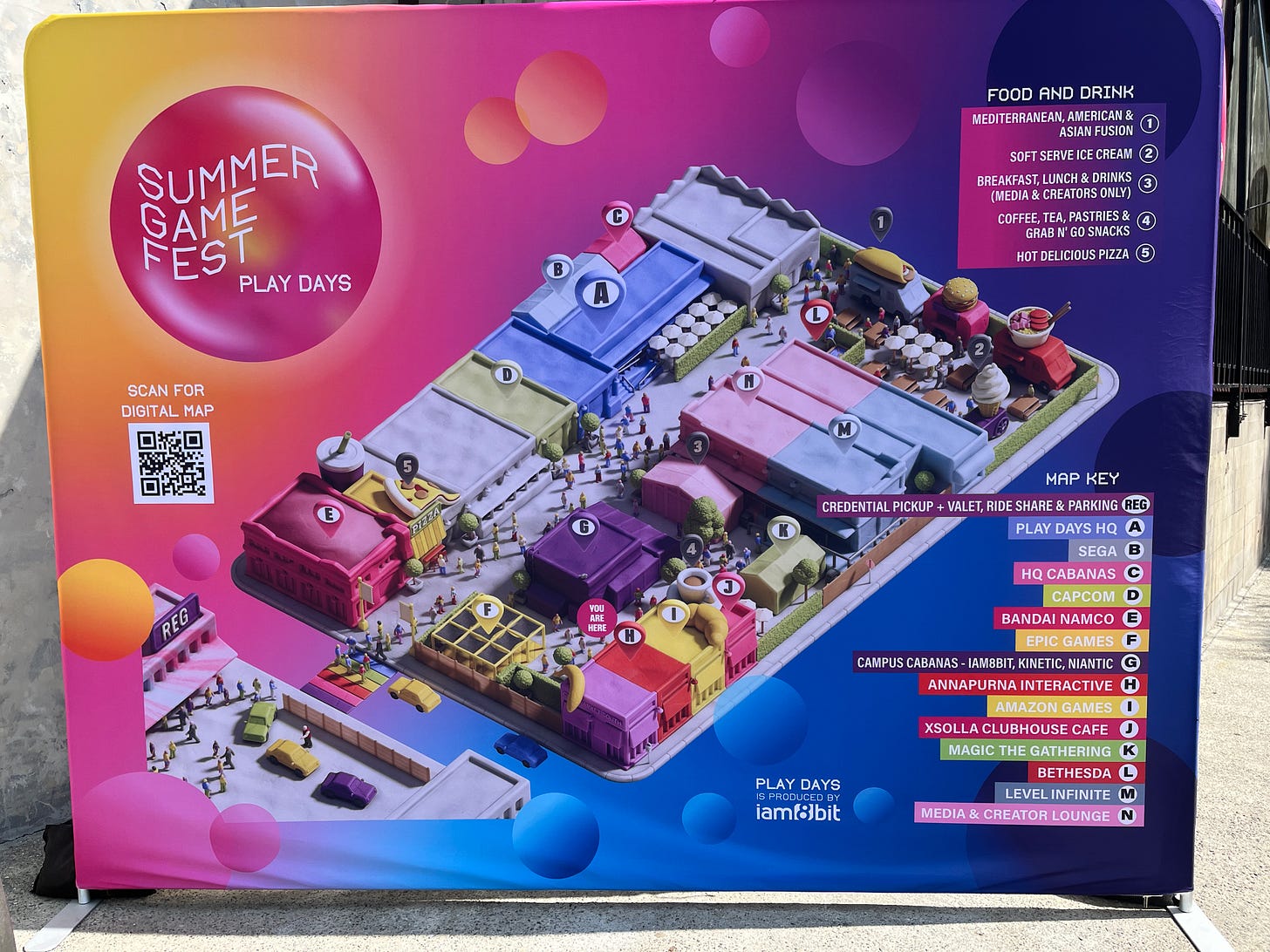
Аренда автомобиля в Дубае для деловой поездки https://xn--80aal0a.xn--80asehdb/auto-news/partner-news/39802-sovety-po-arende-avtomobilja-dlja-biznes-vstrechi-v-dubae.html — разумное решение, особенно если важны комфорт, стиль и пунктуальность. Важно заранее определиться с приоритетами: нужна ли вам представительская модель, вместительный багажник или мощное авто с премиальными функциями. Обращайте внимание на прозрачность условий аренды — наличие скрытых платежей, высокие залоги или штрафы могут неожиданно увеличить бюджет. Обязательно проверьте состояние машины перед выездом: зафиксируйте царапины и вмятины письменно и фото. Страховка с полным покрытием поможет избежать дополнительных расходов. Обратите внимание на систему платных дорог, парковку и ограничения скорости — безопасность и соблюдение правил важны для успеха бизнес-встреч.